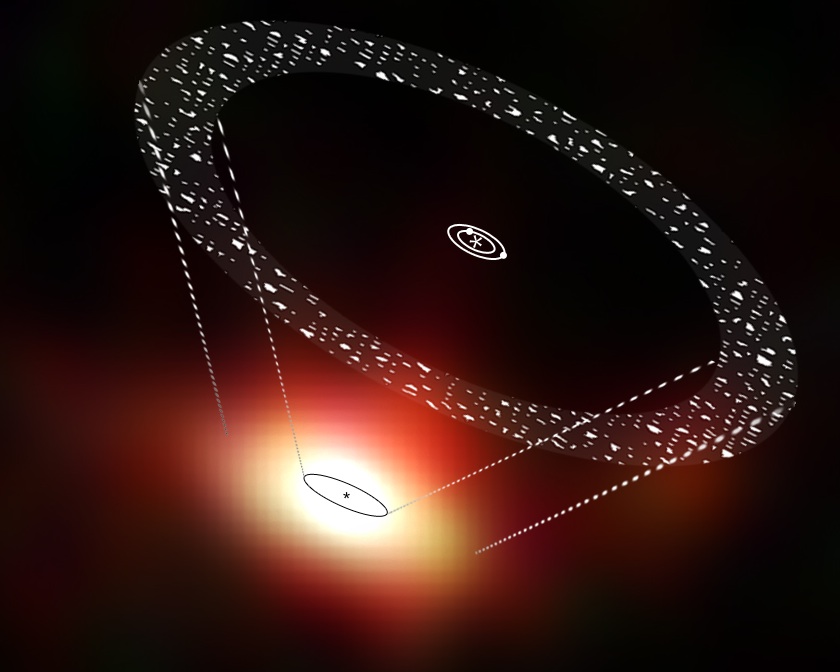
Debris disc around GJ 581
Download:
Artist impression of the debris disc and planets around the star known
as Gliese 581, superimposed on Herschel PACS images at 70, 100 and 160
micrometre wavelengths.
The line drawing superimposed on the Herschel image gives a schematic
representation of the location and orientation of the star, planets and
disc, albeit not to scale.
The black oval outline sketched onto the Herschel data represents the
innermost boundary of the debris disc; the approximate location of the
outermost boundary is represented by the outer set of dashed lines. It
is not possible to identify the central star due to smearing of the
Herschel data.
GJ 581’s planets have masses between 2 and 15 Earth masses and are all
located within 0.22 Astronomical Units (AU, where 1 AU is the distance
between Earth and our Sun) of the central star. A vast debris disc
extends from approximately 25 AU to 60 AU.
Background galaxies are also visible in the Herschel field-of-view.
Credits: ESA/AOES
Using ESA’s Herschel space observatory, astronomers have discovered vast
comet belts surrounding two nearby planetary systems known to host only
Earth-to-Neptune-mass worlds. The comet reservoirs could have delivered
life-giving oceans to the innermost planets.
In a previous Herschel study, scientists found that the dusty belt surrounding nearby star Fomalhaut must be maintained by collisions between comets.
In a previous Herschel study, scientists found that the dusty belt surrounding nearby star Fomalhaut must be maintained by collisions between comets.
In the new Herschel study, two more nearby planetary systems – GJ 581
and 61 Vir – have been found to host vast amounts of cometary debris.
Herschel detected the signatures of cold dust at 200ºC below freezing,
in quantities that mean these systems must have at least 10 times more
comets than in our own Solar System’s Kuiper Belt.
GJ 581, or Gliese 581, is a low-mass M dwarf star, the most common type
of star in the Galaxy. Earlier studies have shown that it hosts at least
four planets, including one that resides in the ‘Goldilocks Zone’ – the
distance from the central sun where liquid surface water could exist.
Two planets are confirmed around G-type star 61 Vir, which is just a little less massive than our Sun.
The planets in both systems are known as ‘super-Earths’, covering a range of masses between 2 and 18 times that of Earth.
Interestingly, however, there is no evidence for giant Jupiter- or Saturn-mass planets in either system.

Debris disc around 61 Vir
Download:
Artist’s
impression of the debris disc and planets around the star 61 Vir,
superimposed on Herschel PACS images at 70, 100 and 160 micrometre
wavelengths.
The line drawing superimposed on the Herschel image gives a schematic
representation of the location and orientation of the star, planets and
disc, albeit not to scale.
The black oval outline sketched onto the Herschel data represents the
innermost boundary of the debris disc; the approximate location of the
outermost boundary is represented by the outer set of dashed lines. It
is not possible to identify the central star due to smearing of the
Herschel data.
The two planets around 61 Vir have masses between 5 and 18 Earth masses
and are both located within 0.22 Astronomical Units (AU, where 1 AU is
the distance between Earth and our Sun) of the central star. A vast
debris disc extends from approximately 30 AU to 100 AU.
Credits: ESA/AOES
The gravitational interplay between Jupiter and Saturn in our own
Solar System is thought to have been responsible for disrupting a once
highly populated Kuiper Belt, sending a deluge of comets towards the
inner planets in a cataclysmic event that lasted several million years.
“The new observations are giving us a clue: they’re saying that in the
Solar System we have giant planets and a relatively sparse Kuiper Belt,
but systems with only low-mass planets often have much denser Kuiper
belts,” says Dr Mark Wyatt from the University of Cambridge, lead author
of the paper focusing on the debris disc around 61 Vir.
“We think that may be because the absence of a Jupiter in the low-mass
planet systems allows them to avoid a dramatic heavy bombardment event,
and instead experience a gradual rain of comets over billions of years.”
“For an older star like GJ 581, which is at least two billion years old,
enough time has elapsed for such a gradual rain of comets to deliver a
sizable amount of water to the innermost planets, which is of particular
importance for the planet residing in the star’s habitable zone,” adds
Dr Jean-Francois Lestrade of the Observatoire de Paris who led the work
on GJ 581.
However, in order to produce the vast amount of dust seen by Herschel,
collisions between the comets are needed, which could be triggered by a
Neptune-sized planet residing close to the disc.
“Simulations show us that the known close-in planets in each of these
systems cannot do the job, but a similarly-sized planet located much
further from the star – currently beyond the reach of current detection
campaigns – would be able to stir the disc to make it dusty and
observable,” says Dr Lestrade.
“Herschel is finding a correlation between the presence of massive
debris discs and planetary systems with no Jupiter-class planets, which
offers a clue to our understanding of how planetary systems form and
evolve,” says Göran Pilbratt, ESA’s Herschel project scientist.
Notes for Editors
ESA
Notes for Editors
ESA
Guillermo Gonzalo Sánchez Achutegui
ayabaca@gmail.com
ayabaca@hotmail.com
ayabaca@yahoo.com
No hay comentarios:
Publicar un comentario